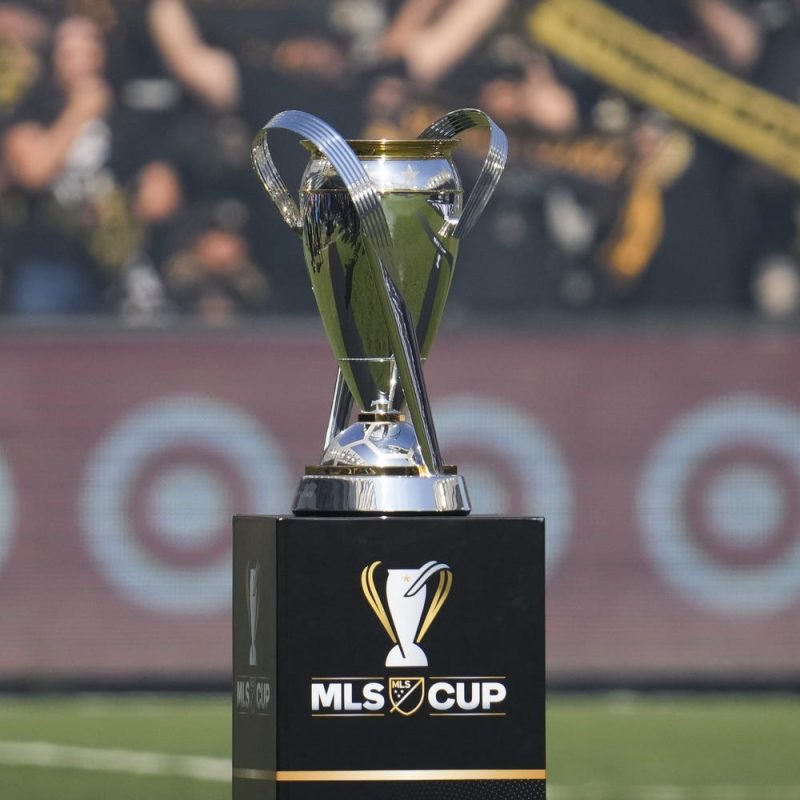Number of teams? Competitions? Length of playoffs? In Major League Soccer, the arrow must always go up.
Just four days before the 2023 season kicks off, the league announced details of a new, expanded postseason structure Tuesday. In a major departure from the single-game knockout set-up seen in recent seasons, MLS will allow nine teams from each conference into the playoffs — meaning that 62% of the league’s teams will get in, and over half will host at least one postseason match — and incorporating a best-of-three format for one round.
That last addition, a convoluted development first reported by The Athletic, is a throwback to the league’s early days. MLS had two different versions of a best-of-three format — one settling tied games with the old 35-yard shootout, and another allowing for ties in a ‘first to five points’ set-up — from 1996 to 2002.
‘Major League Soccer, in concert with the MLS Product Strategy Committee, undertook a review of the playoff format beginning in 2021 to deliver an enhanced playoff format that would provide fans with more games of consequence and better reward regular season results while maintaining the best elements from the single-elimination format,’ said the league in a statement announcing the new format. ‘Incorporating fan research and feedback, MLS engaged a third-party expert in the global sports industry to support the process with data and analysis.’
Per MLS, every playoff game will be available with MLS Season Pass, with commentary ‘in either English or Spanish,’ with matches featuring Canadian sides also having a French-language option.
How do the MLS playoffs work now?
The playoffs will begin shortly after Decision Day, which will see 28 of the league’s 29 teams square off on Oct. 21, the final day of the regular season. The playoffs will open with wild-card games on Oct. 25-26 between the eighth- and ninth-placed teams from each conference, with the higher seed hosting one-off matches. In a concession to the mid-week date and the sheer length of the new playoff format, wild-card games will not include extra time, instead proceeding straight to a penalty kick tiebreaker if the teams are level after 90 minutes.
The winners there will move on to Round 1, effectively a conference quarterfinal round featuring the aforementioned best-of-three format. Those matches, like the wild-card games, will proceed straight to penalties if tied after 90 minutes, and a win in the tiebreaker is just as good as a win in regulation. The first team to win two games advances, with the higher seed hosting games one and (if necessary) three. Round 1 will take place between Oct. 28 and Nov. 12.
With FIFA’s November window falling right in the thick of the playoffs, MLS will take a break from Nov. 13-21, before picking back up for conference semifinals and finals between Nov. 25 and Dec. 3. All playoff pairings past Round 1 will revert to a more conventional one-game format, with ties broken by a more familiar 30-minute extra time and penalties set-up.
The 2023 MLS Cup final will take place on Dec. 9 at the higher seed’s home stadium.
Expansion inevitably means dilution
However, the old format’s single-game format meant that every single game from the start of the playoffs to MLS Cup was must-win. It is true that there were, in gross terms, fewer games where a team’s season was on the line, but in terms of intensity, adding eight games to the playoffs that don’t send anyone home will possibly lower the intensity of the postseason.
There are some clear positives to the new format: 16 of the 18 playoff teams will host at least one playoff match, which means their teams get one more revenue-driving home game, and one that’s an easy sell when it comes to local news outlets that aren’t as focused on MLS coverage. Weird or not, the new format is a boost on that front.
However, that lower intensity from adding games of limited consequence is amplified by a larger playoff field. Teams finishing in eighth and ninth in their conference are by definition not actually having good seasons. In 2022, the ninth-placed team in the East finished 25 points behind the Philadelphia Union, while in the West the gap was 24. In both cases, we’re talking about teams that lost more often than they won, and that has a substantial negative goal difference. Outside of their home markets, any given ninth-place team in an MLS conference is not a team people are clamoring to see get one more game.
Additionally, the structure has gone from one that was as clear-cut as can be to one that is utterly convoluted. Last year, a newcomer could tune into any playoff game and know that the winner advances, and the loser goes home. The format that has turned college basketball’s March Madness into one of the country’s biggest sporting events works in soccer, too.
Now, a casual fan needs a guide. One round is a single-game knockout, but with no extra time. Another round is best-of-three, and can be won by success in a tiebreaker that is merely soccer-adjacent. Then, after that, the single-game knockout is back, but now games can go to extra time? Even for MLS’s oldest heads, it’s an exercise.
That said, MLS clearly made a choice in 1996 and has stuck with it for each of its 28 seasons: the playoff format will be very inclusive. There are more seasons in which 80% of the league got into the postseason than 50%, the lowest-ever percentage (which has only happened twice, in 2010 and 2022). The league has always been like this, and as it continues to grow — St. Louis City SC’s debut brings MLS up to an unwieldy 29 teams — all signs point to a playoff structure that grows with it.
MLS is a strange league, and winning in it has always required adaptation to weird rules and situations. Like it or not, the deeply unorthodox playoff format for 2023 is very much in character.






